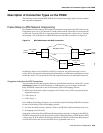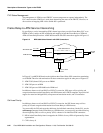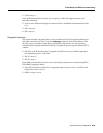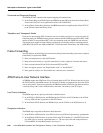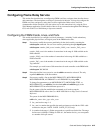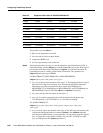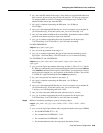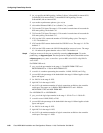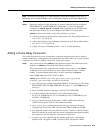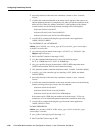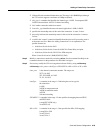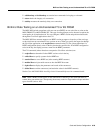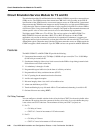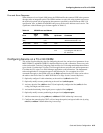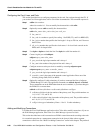
Card and Service Configuration 6-31
Adding a Frame Relay Connection
Note The following step applies to Y-cable redundancy for the MGX-FRSM-2T3E3. For 1:N
redundancy on the eight-port FRSMs, refer to “Redundancy Support by the MGX-SRM-3T3/B.”
Step 7 Optionally configure Y-cable redundancy if you have connected the lines of adjacent
MGX-FRSM-2T3 or MGX-FRSM-2E3 cards through a Y-cable. The applicable
commands are addred, dspred, and delred. These commands run on the PXM rather
than the service module, so you must change to the PXM CLI to execute them:
addred <redPrimarySlotNum> <redSecondarySlotNum> <redType>
• redPrimarySlotNum is the slot number of the primary card. The possible numbers are
1–6, 9–14, 17–22, and 25–30.
• redSecondarySlotNum is the slot number of the primary card. The possible numbers
are 1–6, 9–14, 17–22, and 25–30.
• redType is the type of redundancy. Enter a 1 for 1:1 Y-cable redundancy.
Adding a Frame Relay Connection
This section describes how to add a Frame Relay connection according to the rules for adding a
standard connection or a management connection in the form of either a DAX con or a three-segment
connection. See “Rules for Adding Connections” earlier in this chapter.
Step 1 Add a connection by using addcon. If the application requires the NSAP form for the
endpoint, use addchan as described in the command reference.
The system automatically assigns the next available channel number, so the addcon
command does not require it. However, some related commands require a channel
number. To see the channel number after you add a connection, use dspcons.
On the FRSM-VHS cards (2CT3, 2T3E3, or HS2):
addcon <port> <DLCI> <cir> <chan_type> <egress_service_type> [CAC]
<controller_type> <mastership> [connID] <controllerID>
• port is the logical port number on the MGX-FRSM-2CT3 in the range 1–256. On the
MGX-FRSM-2T3E3 and MGX-FRSM-HS2, the range is 1–2. (See addport step if
necessary.)
• DLCI is the DLCI number in the range 0–1023 (2CT3/2T3/2E3/HS2).
• cir is the committed information rate in one of the following ranges:
for 2CT3, 0–1536000 bps; for 2T3, 0–44210000 bps; 2E3, 0–34010000 bps; and
for HS2, 0–51840000 bps.
• chan_type specifies the type of connection: 1=NIW, 2=SIW-transparent mode;
3=SIW with translation; 4=FUNI, and 5=frame forwarding.
• egress_service_type is a number that specifies the type of queue on the egress:
1=high priority; 2=real-time VBR, 3=nonreal-time VBR; 4=ABR; and 5=UBR.
• CAC optionally enables connection admission control; 1=enable. 2=disable (default).
With CAC enabled, the system adds the resource consumption represented by adding
the connection to the total resources consumed on a logical port.
• controller_type is the controller type for signaling connections: 1 (the default)
specifies a PVC and applies to PAR. 2 specifies a SPVC and applies to PNNI.



